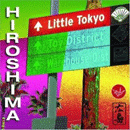 Hiroshima has bridged east and west, jazz and pop, street and spirit, commercial and progressive through 14 albums and almost three decades. Their idiosyncratic instrumentation took them off the beaten path from the beginning, and at times they've seemed to try to stay closer to the middle of the road by putting a good dose of conventional formula music on their albums. Their 1979 debut was driven by danceable beats, through the 80s they flirted with pop and R&B vocals, and when the music smoothed out in the 90s they followed suit. A few tracks always pushed the envelope though. Hiroshima has bridged east and west, jazz and pop, street and spirit, commercial and progressive through 14 albums and almost three decades. Their idiosyncratic instrumentation took them off the beaten path from the beginning, and at times they've seemed to try to stay closer to the middle of the road by putting a good dose of conventional formula music on their albums. Their 1979 debut was driven by danceable beats, through the 80s they flirted with pop and R&B vocals, and when the music smoothed out in the 90s they followed suit. A few tracks always pushed the envelope though.
A band whose conceptual foundation is cultural diversity and whose musical foundation is based on bringing Japanese instruments like the koto and taiko drums into a jazz setting can't always stay in bounds. Over the last few albums they have been filtering out the extraneous elements and honing in on their essential sound. Little Tokyo is their most fully-realized project. It's unadulterated Hiroshima music, and it's a stunner.
The 11 songs on Little Tokyo draw from every imaginable influence - Asian, Middle Eastern, Latin, R&B, pop, rock, chill, Native American, even classical. Through all this territory they never lose their core sound, what could be a hodgepodge becomes a spicy brew. "Midnight Sun" is a showcase. It shifts from a meditative flute and waterfall sound effects June Kuramoto's sharply plucked koto and Dan Kuramoto playing a progressive-jazz line on tenor. Layers of swirling koto arpeggios and synths continue to build around a backbeat provided by two taiko drum masters, Shoji Kameda and his teacher Kenny Endo. "On The Fence" starts out as a fairly conventional sax and keyboard smooth jazz piece with koto interludes until Kimo Cornwell's Rhodes solo over a bass and piano riff that reminds me of "Maputo." "Lanai" was written by James Lloyd of Pieces of A Dream, and it has that elegant sway that characterizes POAD's best songs. But Hiroshima puts their stamp on it with Asian chordings over Lloyd's keyboard textures. "Sir Charles" shifts between a breezy flute and steel drum melody to a darker, denser bridge. This band knows how to use loops and effects with originality. On "Red Beans and Rice," the band has a multi-instrumental free for all over a shifty, syncopated backbeat and a chunky, little loop. The innovative and danceable "Drama" opens with beats and synthesized voices that fade in and out. It's to this point in time what "San-Say" and "Go" were when they came out. "Hiro-Chill" follows with similar textures and grooves. Actually it moves more than it chills, but it has that stark, icy vibe. The lead instrument on "Quan Yin" is the erhu, which sounds like a combination of a violin and a high chanting voice. They give us a lovely lullaby-ish ballad, “Shades of Honor," that builds to a dramatic ending and step into free jazz territory on "Little Tokyo Underground” with Kimo Cornwell just pounding on the piano while Kuramato covers the entire range of the tenor sax. It's so much fun to hear playing like that on an album again!
All these songs open up and bloom as layers of instrumentation and melody shifts occur. It's heady stuff that very few artists could pull off. There is more going on in any given song on Little Tokyo than on many entire albums. The cohesiveness that makes it work undoubtedly comes from the interaction that develops when musicians have been working together for so long. All the songs except "Lanai" were written by members of the band and probably evolved collaboratively. What is fascinating to me is the musical bridges to the pre-smooth era. There are solos and arrangements that will remind anyone who has been around a while of Chick Corea, Weather Report, Les McCann, the progressive sax players on Impulse in the 70s and those delicious contemporary albums that came out on GRP and Warner Bros. in the late 80s and early 90s. But the derivative elements are just layers in this amazing array of sounds, textures, and jaw-dropping instrumental work that make up one of the most amazing musical experiences in recent times. It may be a little startling at first if you're used to safer fare, but there is so much beauty and spirit here to draw you in and keep you listening.
- Shannon West
|

